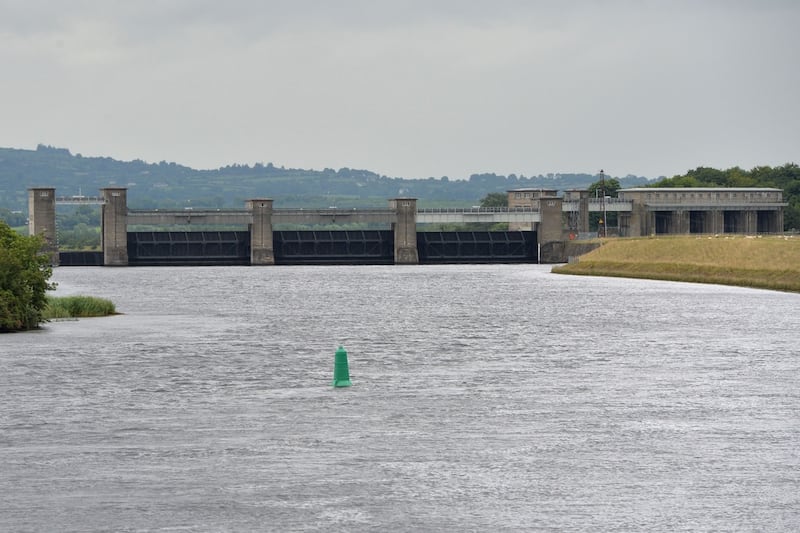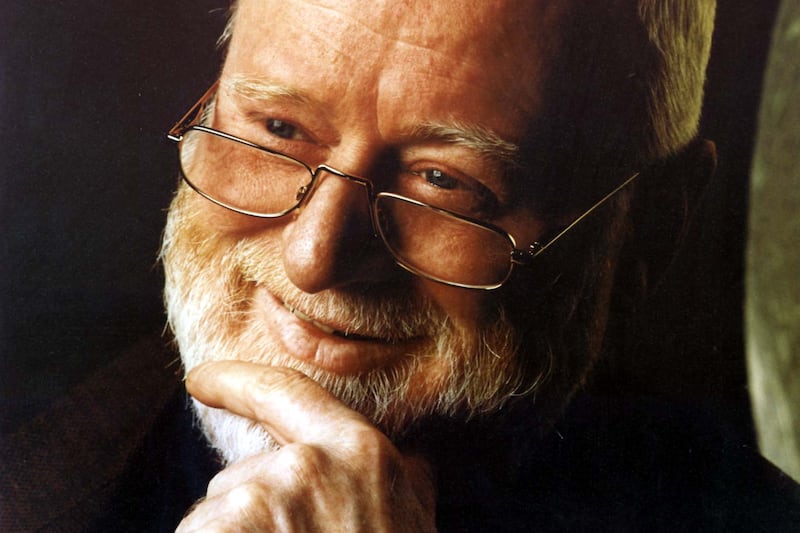It’s home to fewer than 4,000 people, and recently hit the headlines when it became the setting for Matt Damon and Ben Affleck’s new movie. But Cahir, in Co Tipperary, could also be known as the town with the fastest-growing property prices in Ireland over the past year.
A cocktail of too few homes, a drive out of the cities because of increased remote working, and more eager buyers due to a boom in savings during the pandemic is sending prices soaring far above national averages in many parts of the country.
Indeed, Cahir is not alone in posting double-digit growth. New Ross, in Wexford, Skibbereen, in Co Cork, Athy, in Co Kildare, and Glenageary, in south Co Dublin, are just some of the towns and postcodes in the larger cities where prices have grown at far faster rates than national averages.
Overall, property prices rose by 6.9 per cent in the year to June 2021, with Dublin prices up by 6.4 per cent and prices outside Dublin growing by 7.4 per cent, according to figures from the Central Statistics Office.

But when you take a look at price growth by Eircode, which is possible thanks to the CSO’s research, significant disparities emerge right across the country. And these show that prices aren’t all going in one direction: in some places prices have actually fallen – even in parts of the capital.
But what’s driving such sharp price growth in towns like Cahir, and why are prices falling in the heart of Dublin’s city centre?
The towns where property prices are rising fastest
A shortage of properties is what’s driving prices in Cahir, says local agent Tom O’Brien. The town, which is noted for its castle – one of the largest in Ireland – has recorded the fastest-growing property prices in Ireland in the past year, with prices jumping by 23.2 per cent in the 12 months to June 2021.
“Prices are gone way up; the properties aren’t there to sell,” says O’Brien, noting that every house that comes on the market will have six to eight interested buyers. In the spring a semi-detached three-bed home in the town came to the market with bidding starting at €97,000. It sold at auction for €145,000.
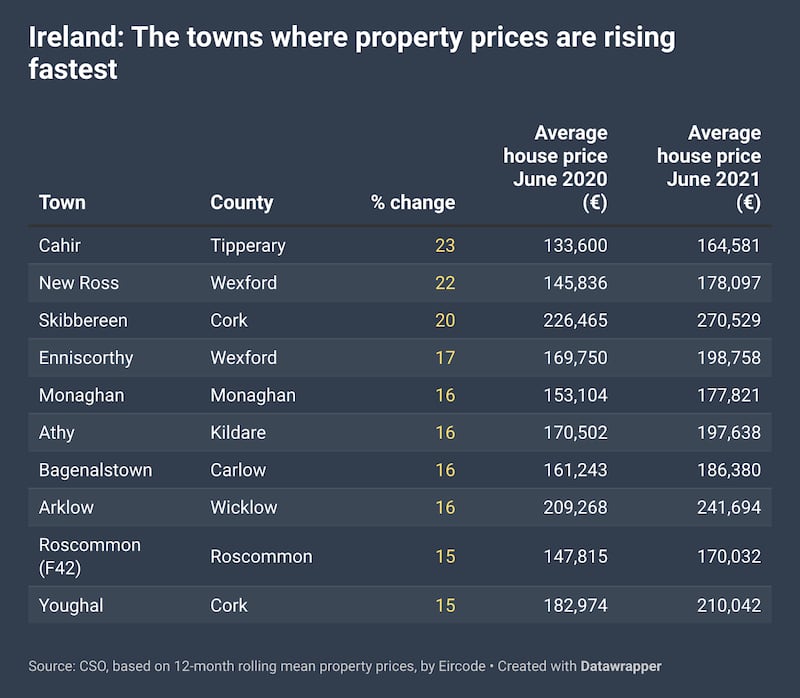
The town is growing, although not with those departing urban areas for a quieter life, says O’Brien; rather, an influx of workers at the nearby ABP Foods meat-processing plant means that demand for property is growing too. New developments have been scarce in the area, but O’Brien hopes that plans for a 45-home scheme will get under way in the coming months.
One factor in the sharp rate of growth seen in the town is that it did have some of the lowest average prices in the country previously. Indeed a year earlier the average sale price in the town was just €133,600; within 12 months this had rocketed to € 164,581.
Transaction levels, however, although down, are relatively in line with norms; back in 2018-19, 75 homes in the town were sold. In the year to June 2021, there were 61 sales.
Sunny southeast
The draw away from the capital has made Co Wexford property ever more attractive over the past 18 months, as it still offers an opportunity for those looking to work from home to commute to the capital a couple of times a week.
New Ross, about 115km from Dublin, 35km from Kilkenny and 23km from Waterford city, offers a wealth of possibilities when it comes to semi-rural living within a stone’s throw of larger urban areas, as well as the scenic beauty of the Hook peninsula.
Its appeal is evident in a sharp rise in prices over the past year, of 22.1 per cent, with average house prices jumping from €145,836 to €178,097.
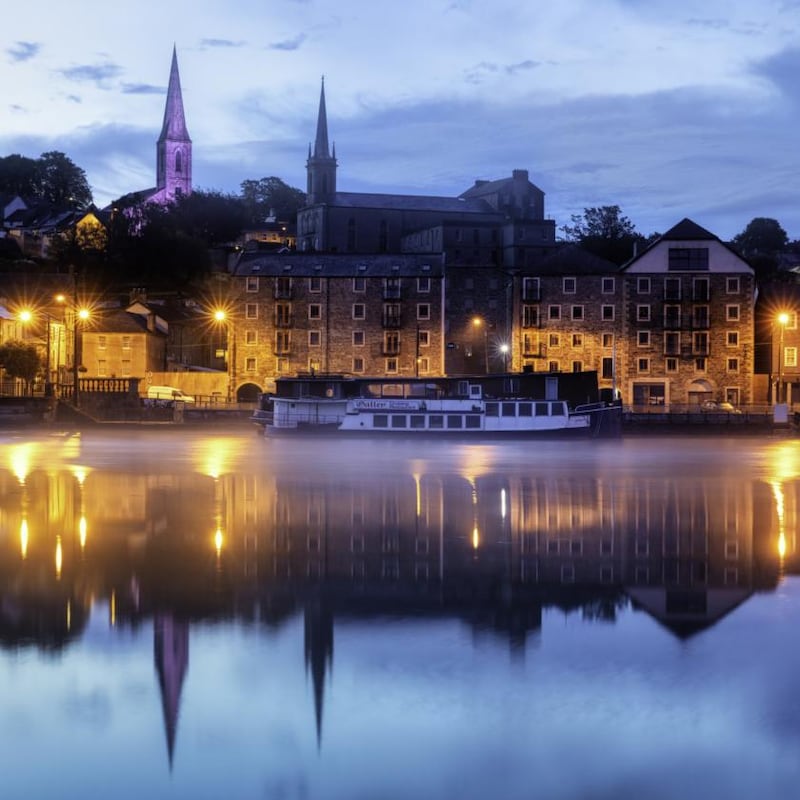
Another Wexford town with higher-than-average price rises is Enniscorthy, where prices rose by 17.1 per cent to an average of €198,758. The county’s second-largest town is also about 115km from the capital, and the jump in prices is likely a factor in Dublin buyers moving that bit farther from the city in search of better value for money.
"There are people moving down from Dublin, but a lot of buyers are local buyers," says Paula Treacy, a local agent, calling the shortage of properties in the area crazy. "It's driving prices up in each case," she says.
As with other towns experiencing sharp price increases, Treacy says prices in the town “were that bit lower” than elsewhere, hence the potential for a bit of catch-up. (Average house prices in Wexford town were €200,544 in June 2020, for example).
Other towns within good commuting distance of the capital – particularly for people who don’t have to commute every day – have also surpassed national averages, with double-digit growth in the past year.
Athy, Bagenalstown, in Co Carlow, and Arklow, in Co Wicklow, have all seen average prices rise by at least 15 per cent over the past year, illustrating the pressure to find a home in the capital’s commuter belt.
Border counties as a whole saw growth of 13.9 per cent in house prices in the year to June 2021. Co Monaghan managed to surpass even this, with annual growth of 16.1 per cent, to bring its average house price up to €177,821. Transactions were also up on the previous year, with 117 sales in the year to June 2021 compared with 106 a year earlier.
Dublin: where property prices are rising fastest
It may already be home to some of Ireland’s most expensive homes, but this didn’t stop property prices from climbing even higher over the past year.
With an average house price of €743,981 in June 2021, up by 12.1 per cent on a year earlier, lockdown didn’t stop bidders shelling out more for a house in Glenageary and Sandycove. In fact it made the area, home to a multitude of swimming spots, such as the Forty Foot and White Rock beach, even more attractive.
The draw to the sea, as seen in the numbers descending on coastal swimming spots at all times of the year, was also at play in the property market, with prices rising fastest across the city in this area.
It means that the postcode, which encompasses Dún Laoghaire, Dalkey and Sallynoggin, now has the third-highest average house prices in the country, behind Dublin 4 (€793,023) and Dublin 6 (€790,260).
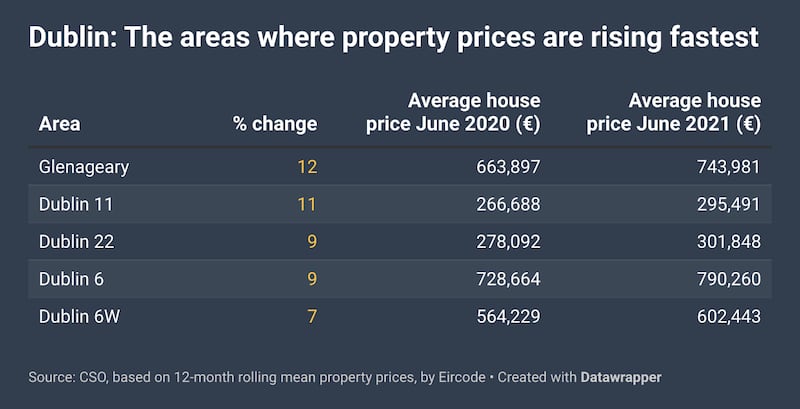
The median sale price, which represents the middle sale price of all houses sold in a period, also rose in the postcode, albeit at a slower rate, up by 7 per cent from €560,000 as of June 2020 to €599,500 a year later.
The number of sales was also strong, at 591 in the year to June, compared with 657 in the same period in 2018-19.
Consider the sale of 45 Arnold Grove in Glenageary. The four-bed semi-detached home came to the market asking €895,000; it ended up going sale agreed at €1,050,000, a difference of more than 17 per cent.

House prices in Dublin 11 also beat trends across the city, with prices advancing by 10.8 per cent, to bring the average house price up to €295,491. The postcode, which encompasses Glasnevin, Ballymun and Finglas, has some of the lower property prices in the city – the average price in June 2020 was €266,688 – which may allow for a sharper increase.
Gerard O’Connor, a local agent, says sales in the area are happening “quite quickly”, noting that a year or two ago a typical sale process would last for four to six weeks. Now it takes just two or three weeks for a property to go sale agreed. “Most people viewing property at the moment are serious bidders: they have mortgage approval and are ready to go,” he says.
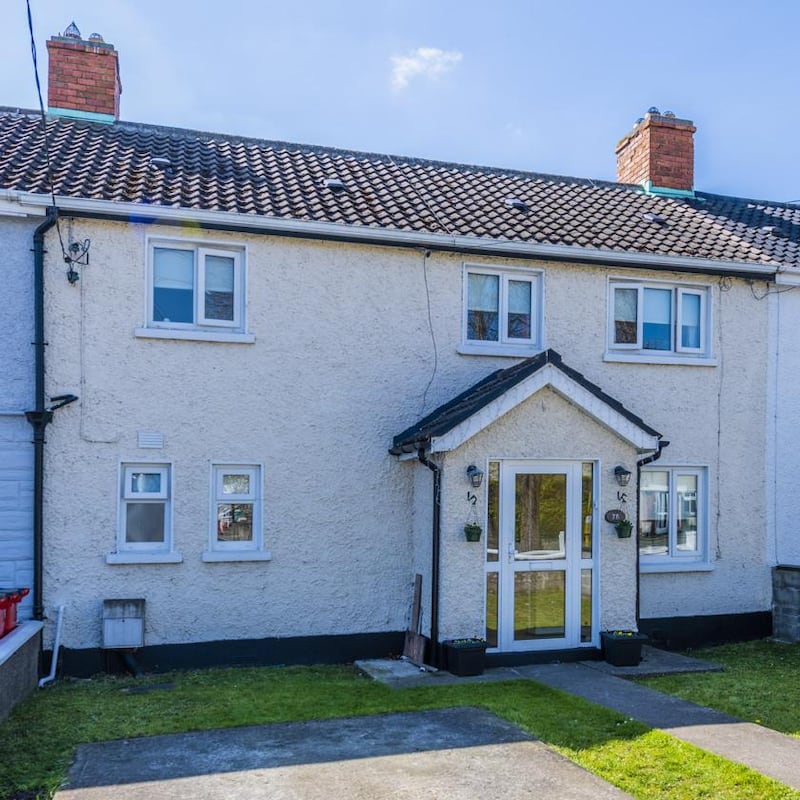
With two to four potential buyers typically bidding, this is pushing prices up: O’Connor has found the difference between asking prices and sale prices in the area is anywhere between 4.5 and 12 per cent .
A factor in price growth in the area, as elsewhere, is lack of supply. But it is also because buyers have more money, with O’Connor noting that while first-time buyers have saved more during the various lockdowns, so too have their parents. “And they’re contributing excess funds they might have saved as gifts to their children,” he says. But despite the recent resurgence he expects price growth to taper off into 2022, and prices to stabilise.
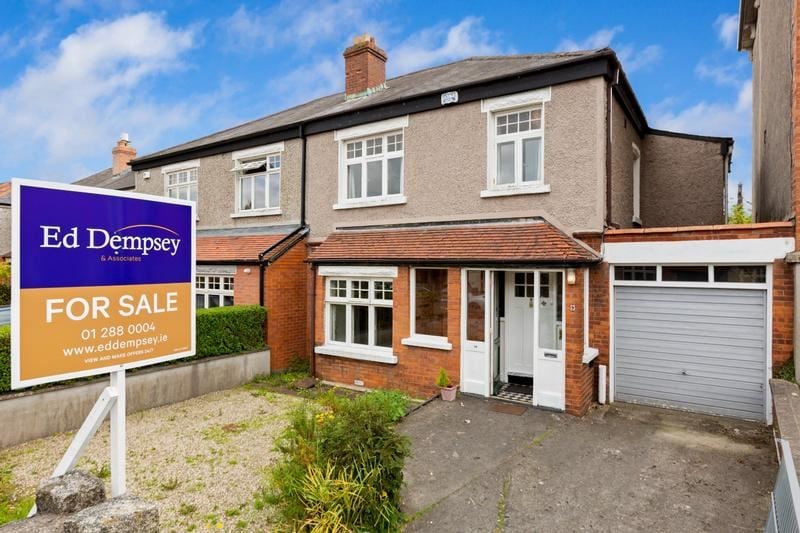
Price growth is also particularly strong in Dublin 6 – Terenure, Ranelagh and Rthamines. For an example of how the boom is getting boomier in the area, look no further than 9 Fortfield Terrace. Frantic bidding during the summer for the four-bed semi-detached home saw the asking price soar from €685,000 to go sale agreed at €1.25 million.The final sale price has yet to show up on the Residential Property Price Register.
Where prices are falling
Although overall trends are very much heading in one direction, this does not mean prices are rising everywhere.
Take Dublin 2. After more than 18 months of Covid-19-related disruptions, and a mass exodus of workers from the city centre, prices have slumped along the south side of the capital’s quays.
According to the CSO, over the 12 months from June 2020 to June 2021 prices slid by about 14 per cent, with the average house price down from more than €500,000 in 2020 to €432,603 a year later – some €71,000 knocked off the price. The median price has fallen even more sharply, down from €503,593 in June 2020 to €363,000 a year later.
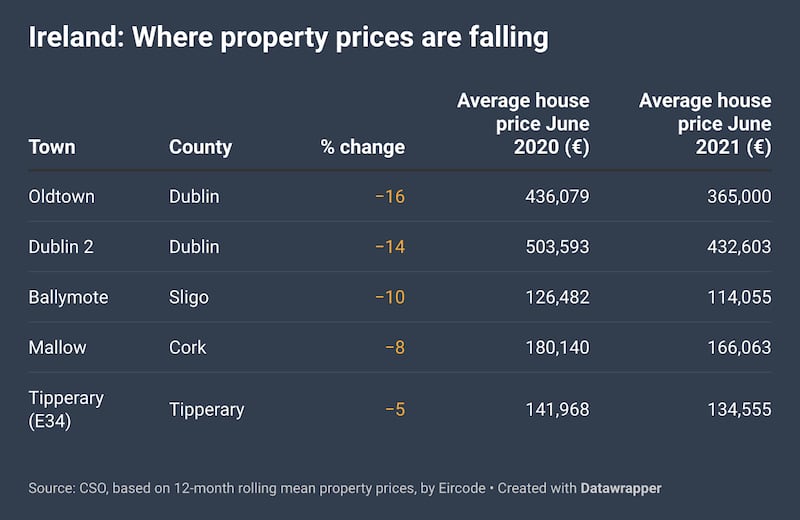
Transaction levels were down on previous years, however; in the 12 months to June 2021 there were 102, compared with 144 a year earlier and 170 the year bevfore that.
Oldtown, in north Dublin, also reported a considerable price drop, of about 16 per cent. Some caution needs to be applied to the interpretation of this figure, however, as transactions were particularly low in the year to June 2021, with just four sales. Nonetheless, sales are typically low in this area, with just seven sales between June 2018 and June 2019.
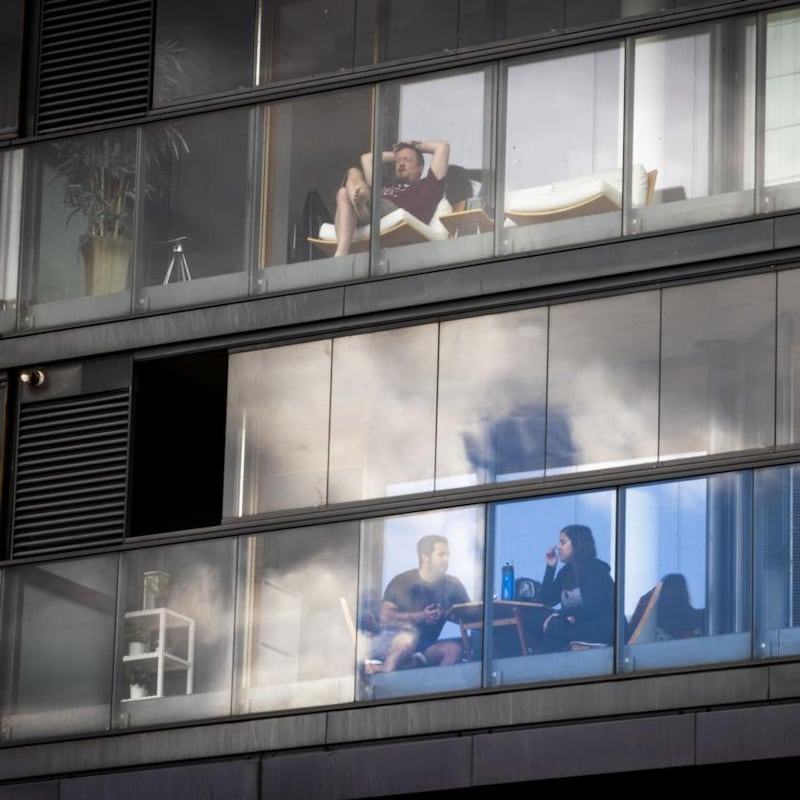
In Co Cork, Mallow is also bucking trends. The former sugar-factory town reported steady sales over the year, at 519, in line with normal volumes. A year earlier there were 528 sales, while back in 2018-19, for example, 581 sales were reported.
But prices slid despite this busy market. Back in June 2020 the average sale price for a house was € 180,140, but 12 months later this had slid by almost 8 per cent, or € 14,077, to €166,063.
This means the town has become more affordable; back in June 2020, based on a 10 per cent deposit and a 3.5-times-income mortgage, a buyer would have needed an income of €46,321 to buy the average house in the town. A year later this had slid to €42,701. The median price also fell, down by 8 per cent to €166,063.
















